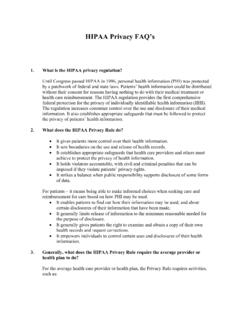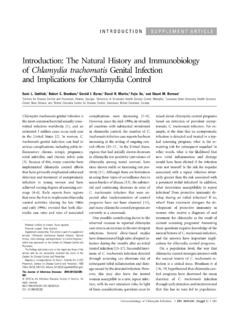Transcription of State of West Virginia DW/DSS Bureau for Medical …
1 State of West Virginia DW/DSS Bureau for Medical Services RFP MED11015 Scope of Work section Page 15 project approach and Solution section 7 Scope of Work Statement of Understanding Over the past year, the Medicaid landscape in this country has changed dramatically due to the Personal Affordable Care Act. As evidenced in her May 6, 2010 remarks about health care reform, US Health and Human Services Secretary Kathleen Sebelius, stated ..this law is the biggest expansion in health care coverage since Medicare. In addition, across the country Medicaid costs continue to grow. The Kaiser Foundation has estimated over 6 percent growth in costs in the next fiscal year.
2 Given the landscape of growth in both member eligibility and program costs, states are looking to leverage information and analytics to effectively manage the Medicaid program in this next decade. One of the first steps in this next wave for West Virginia is the design, development and implementation of a new MMIS Data Warehouse and Decision Support System ( DW/DSS ). The Bureau of Medical Services (BMS) completed the Medicaid Information Technology Architecture (MITA) State Self-Assessment (SS-A) in 2009. The purpose of the MITA State self-assessment is to stimulate an integrated business and IT transformation affecting the Medicaid enterprise. It includes an architecture framework, processes, and planning guidelines that allow State Medicaid enterprises to meet their Medicaid objectives within the MITA Framework while supporting unique needs of the individual State .
3 The findings from the MITA SS-A included: The data and reports submitted to BMS Finance may require a manual reconciliation process to insure accuracy. An outside vendor receives and manages HMO encounter data. When reports used by BMS, vendors and other State entities are run from multiple data stores, the results are not always consistent. For example, in the Office of Quality and Program Integrity (OQPI), the identification and management of cases are currently supported by multiple applications that are not integrated (JSURS, Word, Excel, Access). Data is pulled from multiple sources and must be crosschecked against MMIS claims status. Data is stored in multiple locations and can be difficult to access.
4 BMS program and operations staff does not always have direct access to desired data for program and operations management and decision-making There is no decision support system (DSS) with automated capabilities; analysis capability is inadequate. Obtaining reports from the DHHR data store (DSS) requires MIS intervention and can be a slow and cumbersome process. DHHR MIS staff operates the BMS data store at the direction of Medicaid Finance staff. State of West Virginia DW/DSS Bureau for Medical Services RFP MED11015 Scope of Work section Page 16 During the MITA SS-A, BMS established fifteen (15) goals and associated objectives for the State Medicaid program.
5 The Data Warehouse and Decision Support Initiative ( DW/DSS ) is one such initiative with the following goals: 1. Operations Management Reduce the potential for redundancy in services and payments by establishing integration with other entities Improve access to information necessary for operations management Enhance and automate reporting capabilities to measure compliance with operational performance measures Improve operational efficiency and reduce costs in the healthcare system 2. Program Management BMS plans to use technology tools and provide training for data analysis to enhance decision and policy making capabilities Enhance the ability to analyze the effectiveness of potential and existing benefits and policies through the integration of claims data with clinical data 3.
6 Care Management Improve healthcare outcomes for members Establish access to data from other programs, agencies or entities 4. Program Integrity Management Use decision support capability to support SUR activities Improve data access, data accuracy and the accuracy of process results, as well as reducing the effort required to achieve these results BMS realized that access to timely and integrated information was the catalyst to delivering on the program goals and objectives. New processes, tools and technologies are required to meet the analytical and reporting needs of the current program. In order to support these goals, BMS has plans to implement a DW/DSS that contains static, reconciled data with full decision support capabilities.
7 The DW/DSS will support multiple business units including Finance, Pharmacy, MMIS Operations, Office of Quality and Program Integrity (OQPI), Program Policy, Medicaid Fraud Control Unit (MFCU) and Technology and Reporting. Furthermore, the DW/DSS will support an array of information consumers across business units and potentially outside of BMS including additional State and federal agencies. A subset of information consumers require easily accessible standardized reports that require limited interaction with technology. Data savvy business analysts will leverage the technology provided to slice and dice information, create what if scenarios and predict outcomes and optimize results.
8 The implementation strategy for the DW/DSS is a phased approach designed to mitigate risk by fully defining scope for each phase. The phases include: 1. Phase One: Design, Development and Implementation of the DW/DSS Phase One includes the design, development and implementation of an integrated data warehouse that includes eligibility, finalized claims, encounter, provider, lab and pharmacy data, and reference data. BMS and the preferred implementation partner will follow a standard Software Development Life Cycle (SDLC) to implement this solution. The SDLC includes Visioning, Planning, Designing, Building, Delivering and Operating the DW/DSS . The data required for this initial phase includes current year information plus three (3) years of historical data.
9 Reporting in this initial phase includes financial analysis, standard and ad hoc capabilities, what-if analysis, clinical utilization, care management, and Surveillance and Utilization Review State of West Virginia DW/DSS Bureau for Medical Services RFP MED11015 Scope of Work section Page 17 (SUR). The SUR developed in Phase One is expected to become the CMS certified SUR during Phase Two of the project . The current Fiscal Agent (FA) is responsible for existing Management and Administrative Reporting (MAR), SUR, Medicaid Statistical Information System (MSIS), Home and Community Based Services (HCBS) and Drug Rebate reporting based upon the reconciled data that exists in the DW/DSS .
10 This initial phase ends upon BMS signatory approval of the DW/DSS for production and thirty (30) days of successful operations. 2. Phase Two: Operations and Enhancements a. Operations. Phase Two requires the implementation partner to Operate, Maintain and handle change management activities for BMS. Expectations regarding ongoing operations include operating the DW/DSS with minimal disruption within the service level defined, analyzing and responding to operational issues, maintaining a hosted facility that is conducive to a productive environment, employing competent and professional staff, proactively monitoring system performance and providing a training data analyst for support BMS staff.

















